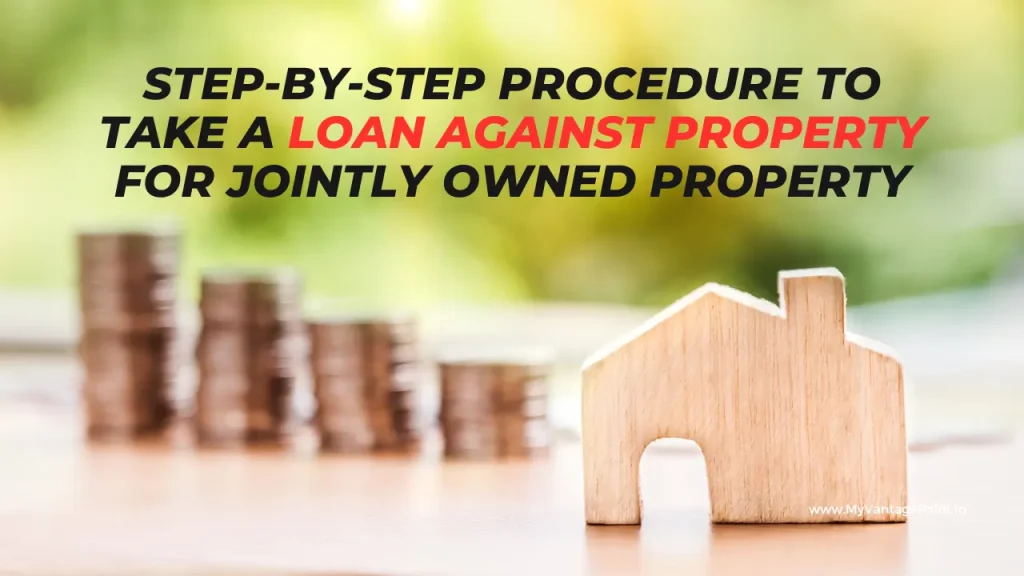Step-by-Step Procedure to Take a Loan Against Property for Jointly Owned Property
A loan against property (LAP) is a popular financing option where you can mortgage your property to get a loan. It allows you to unlock the value of your property without selling it, which is useful for meeting various financial needs, such as business expansion, education, or medical expenses. But what if the property is jointly owned? Can you still take a loan against it?

The answer is yes! You can take a loan against jointly owned property, but the process has a few additional steps compared to individual ownership. In this article, we’ll guide you through the step-by-step procedure for obtaining a loan against property (LAP) for jointly-owned property
Table of Contents
What is a Loan Against Property (LAP)?
Before diving into the procedure, let’s briefly explain what a loan against property (LAP) is. It is a secured loan where you pledge your property as collateral to the lender. The loan amount is typically a percentage of the property’s market value, and the property can be either residential or commercial.
One of the major advantages of LAP is that you continue to own and use the property even after mortgaging it. You simply repay the loan in monthly installments over the agreed tenure.
Can You Get a Loan Against Jointly Owned Property?
Yes, you can get a loan against jointly owned property. However, all co-owners of the property must agree to mortgage the property. Since the property has more than one owner, the process is slightly more complex, and all parties involved must meet the lender’s requirements.
Now, let’s break down the process step by step.
Step-by-Step Procedure for Loan Against Jointly Owned Property
1. Understand the Eligibility Criteria
Before applying for a loan against property (LAP) for jointly owned property, it’s essential to understand the eligibility criteria set by the lender. The general eligibility requirements include:
- Age: Borrowers must be between 21 and 65 years of age.
- Employment Status: Both salaried individuals and self-employed professionals can apply.
- Income: Lenders assess your income to ensure you can repay the loan.
- Credit Score: A good credit score increases the chances of loan approval.
- Property Type: The property should be free from any legal disputes or encumbrances.
Since the property is jointly owned, all co-owners must meet the eligibility criteria or at least be co-applicants in the loan application.
2. Agreement Between Co-owners
The next step is ensuring that all co-owners of the property agree. This is critical because lenders require all co-owners to give their consent for the loan against property. Each co-owner must be willing to be a part of the loan application, and their signatures will be required on all legal documents related to the loan.
If one of the co-owners is unwilling to proceed, you cannot move forward with the loan. Therefore, discussing and obtaining mutual consent is crucial before approaching a lender.
3. Choose a Lender
Once all co-owners agree, the next step is to choose the right lender. Various banks and financial institutions offer loans against property (LAP) with different terms, interest rates, and features. Compare these factors across lenders to find the one that suits your needs best:
- Interest Rates: Look for competitive interest rates to minimize your repayment burden.
- Loan Amount: Check how much loan you can get against the jointly owned property.
- Loan Tenure: Most LAPs come with flexible tenures, ranging from 5 to 15 years.
- Processing Fees: Review any upfront fees or charges imposed by the lender.
Once you’ve shortlisted a lender, you can proceed with the application process.
4. Submit the Required Documents
Documentation is a key step in the loan against property (LAP) process. Since the property is jointly owned, both primary documents and property-related documents will need to be provided for all co-owners.
Here’s a list of common documents required:
- KYC Documents (for all co-owners):
- Aadhaar card
- PAN card
- Passport or voter ID
- Address proof (utility bills, rent agreement)
- Income Proof:
- For salaried individuals: Salary slips, bank statements, and Form 16.
- For self-employed individuals: Income Tax Returns (ITR), profit and loss statements, and bank statements.
- Property Documents:
- Sale deed or title deed
- Property tax receipts
- Encumbrance certificate
- No-objection certificate (NOC) from any housing society (if applicable)
The lender may ask for additional documents based on their requirements. Make sure all documents are clear, updated, and in order.
5. Property Valuation
Once the documents are submitted, the lender will conduct a property valuation. This is to assess the market value of the jointly owned property. The loan amount will typically be 50% to 70% of the property’s current market value.
During the property valuation process, the lender will also check for any legal disputes, outstanding loans, or liens on the property. If the property is legally clear and valued correctly, the loan application will proceed to the next step.
6. Loan Sanction and Approval
Once the property is valued and all documents are verified, the lender will sanction the loan. At this stage, you will receive a loan offer letter outlining the terms of the loan, including:
- Approved loan amount
- Interest rate (fixed or floating)
- Loan tenure
- Monthly EMI
- Repayment schedule
Review the offer letter carefully. If you agree to the terms, sign and submit the necessary documents to accept the offer.
7. Disbursement of Loan
After the loan is sanctioned and the necessary agreements are signed, the lender will disburse the loan amount. This amount is typically transferred to the borrower’s bank account. If the loan against property includes a top-up, the additional funds will be transferred as well.
You will now start repaying the loan in the form of monthly EMIs as per the repayment schedule agreed upon.
Key Points to Remember
- All co-owners must agree to the loan against jointly owned property and sign the necessary documents.
- The property must be free from legal disputes or existing encumbrances.
- Each co-owner’s financial documents and credit scores will be evaluated during the loan application process.
- The property’s market value determines the loan amount you can borrow.
Conclusion
Taking a loan against jointly owned property is a feasible option, but it requires the consent and participation of all co-owners. By following the step-by-step procedure outlined above and ensuring that all the necessary documents are in place, you can successfully secure a loan against property (LAP) to meet your financial needs. Remember to compare lenders, understand the terms of the loan, and carefully review the agreement before proceeding.


















